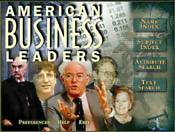
American Business Leaders.
Neil Hamilton.
ABC-CLIO CD-ROM, 1998. System Requirements:
Windows 95, or Windows NT 4.0 (with service pack 3), Pentium-compatible processor running @ 75 MHz or faster, 16MB RAM, hard drive with at least 10MB free recommended, SVGA monitor (640 x 480, 256 colors), Windows-compatible mouse or pointing device, 4X CD-ROM drive, 16-bitsound card. MAC: System 7.5.3 or later, 68040/33 MHz or PowerPC/60 MHz processor or faster, 16MB RAM, hard drive with at least 10MB free recommended, 14-in. monitor (640 x 480, 256 colors), 2X CD-ROM drive.
CD-ROMs may not necessarily affect encyclopedia content, but they certainly transform one's ability to cull information from these reference sources. ABC-CLIO's American Business Leaders, written by historian Neil Hamilton, is an excellent example. The disk contains biographies of
more than 400 major figures in American business history. Though the
entries' substance are not particularly notable, the CD-ROM allows
for a variety of ways to search the database that can aid research
projects in American social, business, and labor history.
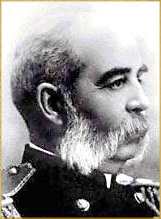 |
Los Angeles Times publisher
Harrison Gray Otis. From
American Business Leaders. |
The basis of American Business Leaders is the individual biographies themselves.
They include 413 personalities spanning virtually every time
period and economic sector.
Each occupies several detailed paragraphs,
and offers a comprehensive sketch of the figure's life and significance in
American business history.
The vignettes provide what can be considered
minor points of interpretation, though they generally put forth arguments
of such breadth and common acceptance that while some may be considered
incomplete, few will find any of them particularly controversial. The
biography of Los Angeles Times publisher Harrison Gray Otis, for instance, mentions both his notable publishing history as well as his
fierce anti-union activities. Each biography ends with a brief
bibliography, most of which are extremely limited and not helpful for
those seeking detailed studies of or sources about the figure. The
bibliography for Harrison Otis, for example, ignores detailed scholarship
on his life and enterprises and instead simply lists David Halberstam's
The Powers That Be.
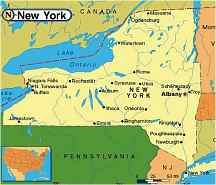 |
Map of New York State.
From American Business Leaders.
|
Each entry contains hypertexts of key words which lead readers to a useful
glossary. Relevant maps are also included, along with the ability to view
the person's life on a timeline of business history.
Those reading about
Samuel Kress and his dime store empire, for instance, can look at a map of
Pennsylvania, or read definitions of "Stock," "textiles," and
"corporations." The timeline feature is not particularly useful. It
simply lists other biographies in the same period alongside a graph of
major events in political history.
Various search engines on the CD-ROM not only make this reference tool
easier to use, but shed much light on the collection's focus and
perspectives. The basic search tool is a name index. Readers can scroll
through an alphabetical list, from Revolutionary-era merchant and
businesswoman Mary Alexander to 20th-century real estate developer
William Zeckendorf. The name index also provides readers a brief summary
of each figure. A subject search is also included which encompasses dozens
of descriptors ranging from advertising (which produces 74 names) to World War II (which produces 65 names).
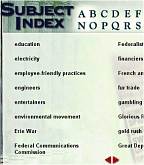 |
| Subject index. From American Business Leaders. |
Key terms range from time periods and type of industry to items such as religion and
"employee-friendly practices." This latter search produces 27 names about which the person's employee relations are discussed. One could
at first view the positive title of the list with suspicion, but the
accounts are moderately balanced. Henry Ford, for instance, is lauded for
paying his workers well, but the sketch also critiques his moralistic
paternalism.
An "attribute search" allows readers to peruse the database by the
categories of occupation, dates of birth and death, gender, ethnicity, and
place of birth. One can imagine students and scholars finding these types
of searches valuable for a variety of research projects. They also make
the group's demographics easy to study. In fact, more notable than the
collection's content may be questions of who was and was not included.
Any effort to create a list of "the nation's business leaders" will
necessarily be incomplete, and this collection of 413 is no exception. The
group is a good example of the traditional canon of American business
history. The list privileges Eastern firms, and leans heavily on the
twentieth century. Manufacturers and financiers are the most represented
groups with 172 and 82 entries, respectively. Agriculture
garnered only 16 biographies, and entertainment only 12. The
selection is a largely white male group. Only eight of the 413 entries are
persons of color, and only 24 are women.
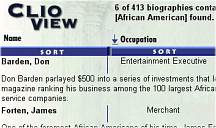 |
African-American biographies listing.
From American Business Leaders.
|
One can of course argue effectively that white males from Eastern manufacturing firms should dominate a list of significant figures in American business history. What becomes problematic about this assertion, however, is when such lists serve to make invisible and limit knowledge about the far wider assortment of players in America's economic development. An Wang, founder of Wang laboratories, is certainly not the
only significant Asian American businessperson in this nation's history,
but he is the only one included here. Similarly, there have been more than
one Hispanic and six African Americans who "have played significant roles
in American business history." Angel Kwolek-Folland's new book,
Incorporating Women, also finds far more than the 24 women who
occupy this database. Such critiques are, of course, easy to make, and I
do not assert that this is inherently an unreasonable list. But it is an
incomplete slice which focuses only on the most chronicled and visible
moments in American business history, and any use of it should be careful
to keep that in mind.
As a reference tool, this is an important and valuable work. It is easy to
use and contains a rich collection of biographies, maps, and timelines.
These along with notebook and bookmark features will serve well history
and business students.
Clark Davis
La Sierra University, Riverside, CA
~ End ~
CD-ROM Review of ABC-CLIO American Business Leaders
Copyright © 1999 by The Journal for MultiMedia
History
Comments
| JMMH
Contents
|
